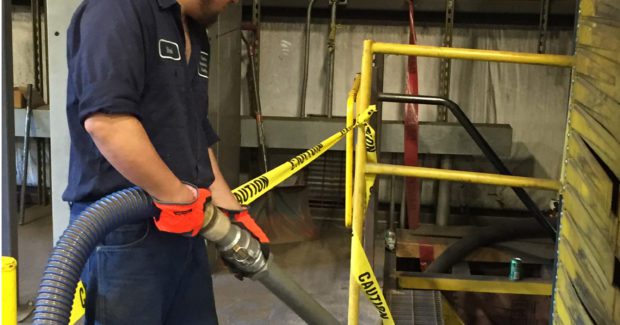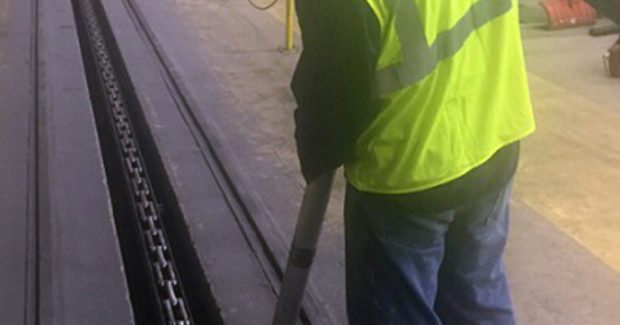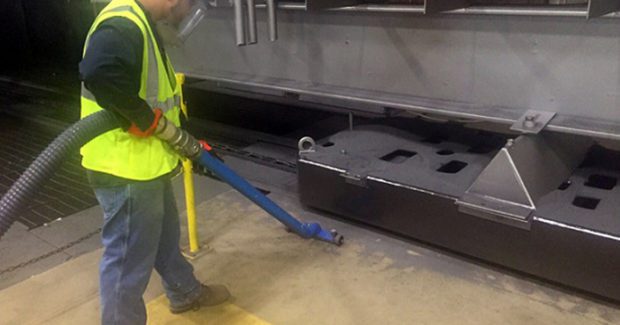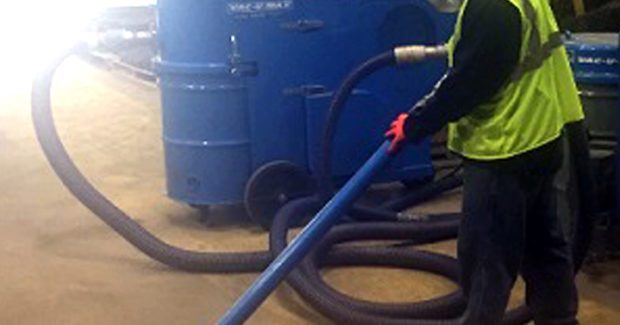Heavy Duty Vacuum Disintegrates Concerns in Abrasive Blasting
Replacing manual removal of steel shot with vacuuming to handle ergonomic concern reduces unscheduled downtime by 80 percent, manpower by more than 50 percent and provides more efficient maintenance of cleaner environment.
Posted: February 20, 2017
Nearly every shop floor manager or supervisor in heavy industry has heard that safety is good for business. According to the OSHA document, Safety and Health Add Value, effective safety and health programs can mean the difference between organizations operating “in the black and running in the red.” Eliminating manual material handling has some of the biggest potential to improve a company’s productivity, product quality, and overall business competitiveness.
Just as safety and health programs are unique to each operation, the ROI of effective ergonomic interventions is also unique to each organization. There are, however, key areas where potential savings regularly occur when implementing a heavy-duty vacuum. Beyond the elimination of ergonomic hazards and injury costs, savings can be found in increased uptime, reduced manpower, increased productivity, improved product quality and a healthier, cleaner environment. When Cianbro Corporation (Georgetown, MA) wanted to eliminate an ergonomic hazard in which workers manually removed steel shot from an auger system connected to a cabinet-style blast machine at their 40,000 sq ft fabrication and coating facility, safety, health and environmental supervisor Kris Chipman researched methods to eliminate manual handling of the heavy material.
This company operates in more than 40 states across a diverse range of markets self-performing civil and structural projects, from building bridges to operating fabrication and coating facilities and working in power plants and paper mills. As a 100 percent employee-owned business, Cianbro has a total commitment to safety, with a long list of safety awards that include national recognition as the Healthiest and Safest Company in America by the American College of Occupation & Environmental Medicine (Elk Grove Village, IL).
The Georgetown facility fabricates structural steel beams for bridge and building projects. Many of these projects begin with beams moving via a conveyor system through a cabinet-style blast machine where steel beads are used for shot targeted at the beam to remove rust and mill scale in preparation for welding or painting. Once the steel shot hits the beam, it drops down into an auger system that reclaims and feeds the material back into the blast machine for reuse over and over again. This sandblasting process is taxing on machinery, and when inherent breakdowns occur workers must remove all of the blast media from the system to perform maintenance. On those occasions, two workers spent eight hours sweeping and shoveling the steel shot into drums and, using a drum dolly, manually moved them from the production floor.
Focused on safety, the goal here was to alleviate the ergonomic issues of shoveling heavy media in a tight space and manually moving heavy drums. In researching for solutions, Chipman had seen some big commercial shop-type vacuums and thought something like that might work. After speaking with a representative from VAC-U-MAX (Belleville, NJ) who had worked on another Cianbro project to vacuum sludge for a bridge application, it quickly became clear that commercial shop-type vacs were insufficient to handle the volume of heavy blast media. “He understood exactly what we were looking for and, after more discussion, we realized this could actually save money on the machine, downtime, production and more,” said Chipman.
VAC-U-MAX, a pioneer in industrial vacuum cleaning and pneumatic conveying industries for over 60 years, has application expertise in the handling of over 10,000 bulk materials, including cast iron, steel, aluminum chips, sludge powders, flakes, granules, pellets and various others. They manufacture industrial vacuum cleaners for manufacturing facilities to improve cleanliness, working conditions and safety. To handle the heavy blast media, the vacuum needed to be designed for high volume recovery in an industrial setting, and their MDL 1020MFS 15 hp continuous duty industrial vacuum was the ideal solution to eliminate those workers from needing to go down into a 3 ft deep trench with limited space and awkward footing to shovel and scoop heavy blast media.
Even though this vacuum is capable of recovering up to five tons per hour and can pick up heavy materials, including steel shot, foundry sand, metal powders, sludges and other materials similar in nature, Chipman wanted final assurance that the unit could pick up their particular blast media. “This is heavy stuff,” he noted. “Each 55 gal drum weighs approximately 2,000 lb and, from the beginning, we weren’t sure if what we wanted to do was even possible. So we sent them a sample of the shot media, they did some testing, and they guaranteed it would work for us.”
Although the portable 1020 vacuum has 14 in large rubber tires and a dual swivel castor wheel that makes it easily maneuverable by a single operator, the shop mounted their unit to a skid. “Push-pull is a hazard in our book, and we do all that we can to avoid it,” added Chipman. “So we mounted this vacuum to a skid and we move it with equipment. It is very portable for us because we have the fork trucks and loading equipment on site to move it around anywhere in our shop that we need it.” As a result of this customer feedback, the Model 1020 is now offered with an optional base for forklift access.
“The great thing about this vacuum system is that the hoses are long enough that we can leave the collection drums where they can be mechanically moved, instead moving drum dollies manually,” remarked Chipman. Since acquiring the vacuum, the facility has cut the labor required to empty the machine by more than 50 percent. The task of emptying the pit, which used to take eight hours utilizing two workers, now takes one worker three hours. “Now we can shut it down in the morning, vacuum it out and have it repaired all in the same day, using one person,” stated Chipman. “The reduced labor on maintenance, which is something that can’t be billed, is now redistributed to work hours on a project that is billable.
Shawn Ramsay, the operations manager of the Georgetown shop, says that in addition to the vacuum, “reducing the risk of injuries and allowing us to quickly and safely clear the steel shot out from the machine pit to perform maintenance, it also proved to be very helpful in the daily maintenance and cleanliness of the areas around the machine.” In an environment where the nature of a blasting machine (in effect) destroys itself over time, reducing the amount of wear and tear can increase the longevity of that equipment and reduce the amount of break downs and unscheduled down time. Because the vacuum makes light work of the heavy blast media, the facility now cleans around the blast cabinet and auger system a couple times a week, reducing abrasion to machine parts.
Before getting the vacuum, the machine used to break down about once each month where all blast media would needed removal for some type of unscheduled maintenance or repair. After implementing the new system, “we’ve only had to clean the entire pit out twice in the last year for unscheduled maintenance, which is an 80 percent reduction in unscheduled downtime and increased production time,” said Chipman. “Of course, being the safety person, it is a lot safer having someone there holding a vacuum than it is to be shoveling heavy media into a drum.”
In addition to using the vacuum for its original task of cleaning steel shot from the blast machine and auger, Ramsay noted that the facility has expanded the use of the vacuum into other areas, such as cleaning garnet from the floor of another blasting area and also in the paint bay. “It has allowed us to clean the areas in a much safer and expeditious manner,” he said. The shop also uses the vacuum to clean up overspray in its coating operation, as well as for general housekeeping on the shop floor.
“When we do a good clean up we utilize the vacuum and it is a lot faster and more efficient than just sweeping. And it gets it cleaner,” smiled Chipman. “This vacuum is an investment, but when you look at the potential for injury and on top of that potential, show hard numbers that we know this will limit downtime and its related costs, plus reduce replacement parts and wear and tear while increasing the longevity of the equipment, the payback makes it easy to put a case together to make the investment.”
Cianbro Corporation, 3 Farm Ln, Georgetown, MA 01833, 978-352-2591, www.cianbro.com.
VAC-U-MAX, 69 William Street, Belleville, NJ 07109; 973-759-4600, info@vac-u-max.com, www.vac-u-max.com.













